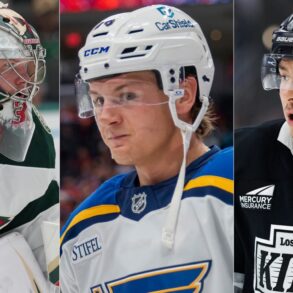
Twenty-five years from now, fans viewing the Official Guide and Record Book will see that in 2024-25, Connor McDavid hit the century mark in total points.
Again.
It will look like just one more brilliant season stacked on another, as far as the eye can see.
However, the 2024-25 season was the most unusual of his Edmonton Oilers career.
McDavid’s consistent brilliance is a rare thing in the NHL, especially since his peak performance is at the outer marker of excellence. For his generation, he sets the bar annually.
From his rookie season through this one, his individual five-on-five points per 60 ranged from 2.62 (2021-22) to 3.58 (2020-21) and 3.50 (2023-24).
Advertisement
His scoring prowess is legendary. With McDavid on the ice at five-on-five, the Oilers basically have a power play. This season started and ended that way. There were bumps in between, though, and that’s the subject of our conversation.
What happened?
McDavid’s five-on-five scoring by month
History tells us that a player with an established level of ability loses it only when injured, when his role changes or he succumbs to aging. McDavid’s consistency is legendary, so struggling at 28 suggests injury is the only reasonable conclusion for a short-term downbeat in production.
Looking at the captain’s five-on-five points per 60 and goal share during each month allows us to identify the period where nothing rhymed:
| Month | Pts-60 | Goal Pct |
|---|---|---|
|
October |
1.93 |
57 |
|
November |
3.17 |
48 |
|
December |
3.37 |
65 |
|
January |
2.08 |
55 |
|
February |
0 (8 games) |
13 |
|
March |
3.45 |
67 |
|
April |
5.9 (4 games) |
100 |
Five-on-five totals, via Natural Stat Trick
The month of February, eight games in all, stands out as a major fall in production. The goals weren’t there, the outscoring vanished, and the Oilers were unable to play competitive minutes with McDavid on the ice.
That kind of fall-off in performance screams injury. McDavid scored a famous goal at the 4 Nations Face-Off in February, and in that game, many commentators discussed that he appeared to be playing at less than 100 percent. Those observations were also made during Oilers games in this part of the schedule.
McDavid did miss some games around Halloween due to an ankle injury. He also missed three January contests due to suspension and eight games to injury at the end of March.
In February, McDavid played. He delivered his least effective month in an Oilers uniform. On the other hand, he scored one of the biggest goals of his career at the 4 Nations.
He wouldn’t be the first player to keep going during an injury in order to play important games, NHL and otherwise.
What about the goalies?
I’ve written on this subject several times over the winter, theorizing about all manner of issues (aside from injury). What about goaltending? This would have to be filed under bad luck if Edmonton’s goaltenders (mostly Stuart Skinner and Calvin Pickard) were less successful when McDavid was on the ice for the entire year. Here are 97’s numbers on and off the ice during 2024-25.
| Month | GA-60 w/97 | GA-60 w/o 97 |
|---|---|---|
|
October |
2.32 |
2.29 |
|
November |
4.44 |
1.82 |
|
December |
2.07 |
2.14 |
|
January |
2.67 |
2.03 |
|
February |
5.56 |
2.3 |
|
March |
2.07 |
3.31 |
|
April |
0 |
2.59 |
Five-on-five totals, via Natural Stat Trick
There were two months during the regular season when McDavid’s line received below-average goaltending (based on GA-60). The November dive can be blamed at least in part on the goaltending, but the February numbers reflect what was a difficult month for McDavid and his linemates.
Advertisement
It’s extremely likely he was dealing with a specific physical issue in the month, and reasonable that it impacted other months during the season.
The goalies weren’t helping enough in November and March. It would be incorrect to blame the goalies completely.
What about the linemates?
McDavid’s linemates through much of the season were Ryan Nugent-Hopkins and Zach Hyman.
The trio delivered a 50 percent goal share (50 percent expected) in October and November. The expected goal share in November (76 percent) was exceptional and confirms that goaltending was an issue for the line in late fall.
By December, the top line was smashing opponents (86 percent goal share) and was now outscoring expectations (56 percent expected).
January was a struggle until coach Kris Knoblauch changed out Nugent-Hopkins. McDavid and Hyman with Leon Draisaitl scored 75 percent of the goals and a whopping 6.50 goals per 60.
Although February was a disaster, the Draisaitl-McDavid-Hyman trio still scored at 50 percent at five-on-five. The magic wand that is McDavid-Draisaitl remains intact.
Why did it get better?
March saw the big line (with Draisaitl and Hyman) remain together; the domination continued. The trio scored at a screaming rate in the month (7.91 goals per 60) but the Oilers were suffering badly (1.26 goals per 60) at five-on-five with the trio off the ice.
At some point, Knoblauch made a decision to run McDavid with two depth wingers, Jeff Skinner and Connor Brown. It’s likely the idea came due to the low scoring rates with the big line off the ice.
The line clicked.
Since April 1, Skinner-McDavid-Brown have played 44 minutes together, scoring 5.39 goals per 60 (4-0 goals) with 72 percent expected goals.
It’s a small sample, but this has a massive possible impact on the team’s scoring and outscoring on the second and third lines.
Advertisement
Armed with Draisaitl and Nugent-Hopkins as the No. 2 and No. 3 centres, Knoblauch can run any number of capable veterans on those lines. He used Vasily Podkolzin and Viktor Arvidsson with Draisaitl often this year, but if the trio gets stale, it’s possible Hyman runs on that line.
If Hyman isn’t needed there, Edmonton can use him on the third line with Nugent-Hopkins. What’s more, Hyman is adept at playing either wing, meaning all manner of forwards could populate the third line.
This is especially useful because of a player like Corey Perry. The coaching staff could dress the veteran on the fourth line, but move him up if things aren’t clicking with the planned alignment.
To hell and back could be worth it
This unusual McDavid season may have brought a silver lining as spring arrived. The captain found the outscoring range with wingers who were not considered optimal for most of the campaign.
The chemistry found with McDavid, Skinner and Brown could gift the rest of the roster with the kind of exceptional outscoring depth required to win the Stanley Cup.
If it works, 25 years from now, they can tell everybody they planned it.
(Photo: Danny Wild / Imagn Images)
This post was originally published on this site be sure to check out more of their content.








